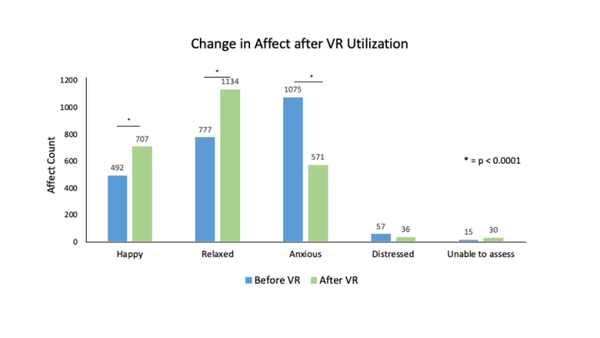-
Home
-
About JCTR
-
Gold Open Access
-
Issues
-
Editorial board
-
Author guidelines
-
Publication fees
-
Online first
-
Special issues
-
News
-
Publication ethics
-
Partners
-
Submit your manuscript
-
Submit your review report
-
Editorial Office
-

This work is licensed under a Creative Commons Attribution-NonCommercial 4.0 International License. ISSN print: 2382-6533 ISSN online: 2424-810X
Volume 7 Issue 6
Real time reorientation and cognitive load adjustment allow for broad application of virtual reality in a pediatric hospital
Thomas J. Caruso*, Ahtziri Fonseca, Ariana Barreau, Michael Khoury, Maria Menendez, Ellen Wang, Kiley Lawrence, Christian Jackson, Samuel Rodriguez
Caruso et al. J Clin Transl Res 2021; 7(6):6
Published online: November 6, 2021
Abstract
Background: With a new generation of affordable portable virtual reality (VR), clinicians are discovering more utility for VR, while also identifying opportunities for improvement, such as the inability to reorient the horizon line during repositioning or transport, or modulate cognitive load in real time.
Aim: At our institution, this lack of functionality prohibited or decreased VR usage in some clinical scenarios such as dressing changes with dynamic positioning. The purpose of this brief report is to describe the development and use of a VR application that is optimized for the healthcare setting and report historical effect of patients who utilized VR as supplement to Child Life procedures. Eligible affects per chart review included Happy, Relaxed, Anxious, Distressed, Unable to Assess.
Methods: Given the need for real time reorientation and cognitive load modulation, we created the Space Pups™ VR application. The experience was launched as part of the Stanford Chariot Program in the summer of 2017, and its usage tracked through the electronic medical record and a VR application dashboard. Chart review was queried from 3/1/2018 to 9/8/2021 for pediatric patients who used virtual reality with real time reorientation and cognitive load modulation as a supplement to their Child Life interventions.
Results: The Space Pups™ experience has been successfully used in a variety of settings, including perioperative care, vascular access, wound care, and ENT clinic, a total of 1696 times. Patients ranged from 6 years to 18-year old, with no reports of side effects. Significant results (p<0.001) were observed pre- and post-VR use for affect improvements in Happy, Relaxed, and Anxious, but not for Distressed.
Conclusions: The ability to reorient VR experiences in real time has increased functionality where other applications have failed.
Relevance for patients: While more studies are needed to quantify the anxiolytic and pain-reducing effect of Space PupsTM, our report demonstrates the feasibility of this VR experience as a non-pharmacological modality to safely increase patient cooperation in a wide variety of clinical settings.

DOI: http://dx.doi.org/10.18053/jctres.07.202106.006
Author affiliation
1. Department of Anesthesiology, Perioperative, and Pain Medicine. Stanford University School of Medicine. Stanford, CA, USA, 94304
2. Stanford Chariot Program. Lucile Packard Children's Hospital. Palo Alto, CA, USA, 94305
3. Department of Anesthesiology, Perioperative, and Pain Medicine. Massachusetts General Hospital. Boston, MA, USA, 02114
*Corresponding author
Thomas J. Caruso
Department of Anesthesiology, Perioperative, and Pain Medicine. Stanford University School of Medicine. Stanford, CA, USA, 94304
Email: tjcaruso@stanford.edu
Handling editor:
Michal Heger
Department of Pharmaceutics, Utrecht University, the Netherlands
Department of Pharmaceutics, Jiaxing University Medical College, Zhejiang, China

